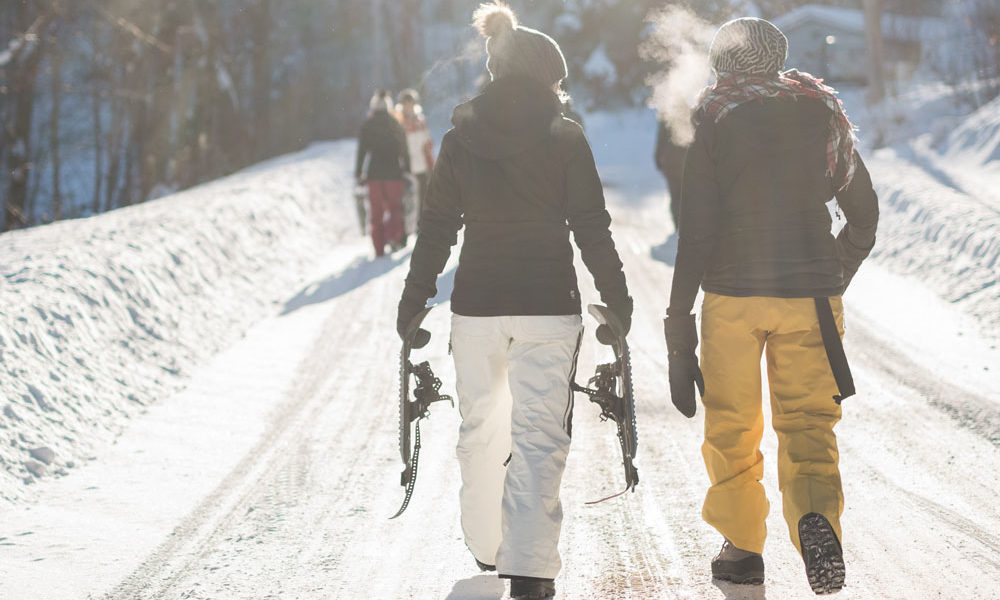After a two-hour drive to the Blue Mountain area, I get out of my car to gear up in the Duntroon Highlands parking lot. Expecting to spend at least five hours outside on trails with the temperature dipping to minus six, I’m well dressed. I leave just slivers of exposed skin between my faux fur pom toque and my sunglasses and my snood, that doubles as a face mask indoors. Do I put on sunscreen?
It wasn’t sunny. You could barely see through the snow being picked up by the wind. And it was freezing. I comforted myself that walking in snowshoes would keep me warm. As for the sunscreen, I put it on.
I signed up for the Neutrogena 7 Summits Snowshoe Challenge, which was to raise funds and awareness for Melanoma Network of Canada. Here, I meet Falyn Katz, executive director of the non-profit, and dermatologist Dr. Julia Carroll, to confirm the obvious: Yes, you need to wear sunscreen every day, not just in the summer. Read on for deeper answers to this question and more.
Do I need to wear sunscreen in the winter?
“You wouldn’t think so, but the sun and the UV (ultraviolet) rays reflect off ice and snow,” says Katz. “So, it makes them twice as dangerous, because they’re hitting you from the sky and again off the ice and snow. The sun is just as damaging to the skin in the winter months as it is in summer months. We often see melanomas on the face, neck and head, so we need to protect ourselves year round.”
When it comes to winter sports Dr. Carroll says that altitude matters, since you’re closer to the sun’s rays. “Ultraviolet A rays don’t change based on the season. Wherever you are in the world, ultraviolet A rays are the same all year long. Those are the UV rays that penetrate deeply in the skin and can cause skin cancer.”
Here’s what a dermatologist wants you to know about common sunscreen myths.
Who is at risk for skin cancer?
“Unfortunately, the numbers are rising in Canada, especially among young Canadians,” says Katz. “We’re seeing a lot of teenagers and those in their 20s and 30s, being diagnosed. Also, skin is more sensitive when a woman is pregnant. And we see, unfortunately, instances in pregnant women and new moms, as well. It’s one of few cancers that can be prevented by taking these measures. So if we wear our sunscreen cover up, seek shade during the peak UV hours, we can help.
When are peak UV and sun hours in Canada in the fall, winter and spring?
In the summer, peak times are 11 a.m. to 3 p.m., and Katz confirms that it’s the same time of day, no matter the season. Even on rainy, cloudy days.
How do you remember to wear sunscreen every day?
It’s about creating a habit out of it, recommends Dr. Carroll. “Just like when you get on a bike, you put on a helmet. When you get in the car, you put on a seatbelt. Every morning, when I wake up, I put on sunscreen as part of my daily routine no matter the weather.”
She washes her face, uses her serums and moisturizer, and her final step in her skincare routine is sun protection. Then she applies makeup.
Here’s what you need to know about sunscreen recalls and benzene.
How to apply sunscreen when the weather is cold
You will want to put it on before you head out the door, then apply it again when you have lunch. Generally you apply it every two hours. Dr. Carroll says to think of it like a lip balm. “It’s something to keep in your ski bag or the pocket of your jacket.” Plus, that’ll keep it from being too cold to apply.
Wind burn vs sunburn: What causes the redness on skin?
Dr. Carroll says it’s likely both. “If your face is exposed enough to get wind burn, it is probably exposed enough to get sunburnt,” she says. “It’s very difficult to tell those two apart. But the nice part is, if you’re putting on sunscreen, particularly one that’s moisturizing, it gives a nice protective layer on your skin, both for the sun and for the wind. It’s a double-double win.”
Are clothes enough to protect us from the sun?
You can buy summer clothes with UPF (ultraviolet protection factor). But what about other seasons? A quick test, according to Dr. Carroll, is to hold it up, stretch it out and see how much light is coming through.
My red toque checks, as does my ski jacket and pants. My paper face mask – not so much. Good thing I wore a snood that day.
For more information visit melanomacanada.ca, where Katz recommends a variety of resources, including a mole tracker card. She also recommends this video from Neutrogena for doing a skin check. And when you see your healthcare provider, “Ask questions,” she says. “You are your biggest advocate when it comes to your health. So champion and ask about your risk.”

